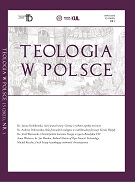Obok obowiązującej po soborze chalcedońskim formuły określającej osobę Jezusa Chrystusa istniejącego „w dwóch naturach” Wigiliusz z T apso używa formuły „z dwóch natur”, co mogło budzić uzasadnione obawy, zwłaszcza w środowisku łacinników. Jednakże posługiwanie się obydwoma formułami nie koncentrowało prawdy dogmatycznej wokół jednej tylko koncepcji, zostawiając tym samym jakże cenne pole do dialogu. Dlatego też sposób, w jaki Wigiliusz zamiennie używa formuł definiujących egzystencję obydwu natur w jednej osobie Jezusa Chrystusa, jest przykładem właściwie rozumianej ortodoksji, przez co sam autor Contra Eutychetem jawi się jako teolog szukający odpowiedzi na wymagania czasu, w którym żyje.
Jesus Ch rist in two or from two na tures? – a reception of Chal cedon dogma in Contra Eutychetem by Vigilius of Ta psus
Summary
One of the essential problems after the Council of Chalcedon was an issue of reception of a dogma of hypostatic union of Jesus Christ. This process, although very dramatic, with numerous connotations, especially political, did not overshadow strictly doctrinal debate. One of the participants of this debate in the circle of the Latin language was Vigilius, the bishop of Tapsus in North Africa. In his work Contra Eutychetem, written probably between year 460 and 480, he defends the decision of the Council of Chalcedon and the teaching of Pope Leo I, as to the manner of existing both natures in Jesus Christ, contained in the phrase in duabus naturis. At the same time he does not resign from using a „competitive“ phrase ex duabus naturis. In this way he proves the complementarity of both phrases, not affecting the substance of the Chalcedon dogma.
Ostatnia aktualizacja: 06.07.2013, godz. 19:39 - Natalia Haniewska































